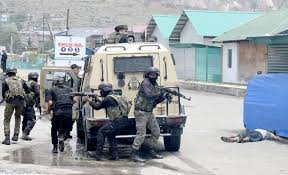In Pahalgam attack shadow, Amarnath Yatra sees a dip in registrations

The sacred Amarnath Yatra, a spiritual journey to the Himalayan cave shrine in Jammu and Kashmir, has suffered a noticeable dip in registrations this year. The April 22 terrorist attack in Pahalgam shook public confidence. The deadly ambush killed 25 people, including tourists and a local guide. As a result, many pilgrims and their families are now reconsidering the annual trek.
A Sacred Route Tainted by Violence
Pahalgam, once a peaceful starting point for the pilgrimage, turned into a site of tragedy. Gunmen opened fire on a group of tourists, causing panic and chaos. Security forces acted swiftly, neutralizing some suspects, but the damage had been done. News of the incident spread quickly, creating fear across the country.
This attack didn’t just hurt tourism in the short term. It triggered emotional distress among families planning to undertake the Yatra. Many who were once eager to register are now opting to wait—or to cancel entirely.
Registrations Plummet in Multiple States
Across India, several regions are reporting sharp drops in Yatra registrations. In Rewari, Haryana, a bank that used to process 25–30 daily registrations now handles just four. Staff members say people are collecting forms but not returning to submit them.
In Dhanbad, Jharkhand, the number of pilgrims applying for medical fitness certificates has declined. Previously, 16–20 people would visit clinics each day. Now, doctors see only four to six applications daily.
Gujarat, a state that usually sends large groups of pilgrims, has also experienced a major decline. Travel agents in Vadodara report that bookings are down by over 90%. Where 150–300 people came daily for fitness checks, only 20 showed up in a recent four-day period.
In Bulandshahr, Uttar Pradesh, the dip is equally stark. Banks saw only 40 registrations over five days, far below their earlier average of 40–50 per day. Some pilgrims have already cancelled their trips.
These numbers reveal a clear trend: the Pahalgam attack has deeply influenced public sentiment. Fear is overtaking faith in many parts of the country.
But Some Regions Stay Steady—or Even Grow
Surprisingly, not all areas have seen a decline. In Mohali and Chandigarh, registrations have increased compared to last year. Mohali has issued 550 Yatra permits in just 15 days, compared to 500 over six weeks in 2024. Chandigarh has processed over 700 permits, doubling last year’s pace.
Pilgrims in these areas seem more confident in security arrangements. Many also express deep faith that overcomes fear. Local officials believe awareness drives and trust in the system may be driving these numbers.
Authorities Respond with Strong Security Measures
To restore public confidence, the government has launched several safety initiatives. The Yatra will now run from July 3 to August 9, shortened to 38 days for tighter control and quicker responses.
Over 35,000 security personnel will be stationed across the route. Forces include the CRPF, BSF, and local police units. Authorities have installed 4,000 CCTV cameras equipped with facial recognition technology to monitor crowds in real time.
To prevent aerial threats, officials have declared the Yatra zone a no-fly area. From July 1 to August 10, drones, paragliders, and balloons are strictly banned. These restrictions aim to eliminate risks of airborne attacks or surveillance.
The administration is also improving mobile connectivity and emergency healthcare. Medical camps and communication centers are being upgraded along both the Pahalgam and Baltal routes. Officials say they are doing everything possible to protect pilgrims.
Pilgrims Caught Between Faith and Fear
Despite the precautions, many potential yatris remain hesitant. Families are urging elders and children to delay or skip the pilgrimage this year. Travel agents report a rise in cancellations and queries about refund policies.
Ashok Mehta, a travel coordinator in Vadodara, shared, “Last year, I arranged for 300 people. This year, just 30 have confirmed. Everyone wants to wait and see.”
Still, not everyone is backing out. Meena Joshi, a 58-year-old from Jaipur, remains firm in her decision. “I trust Lord Shiva and believe the army will protect us. This is not just a journey—it’s a calling,” she said.
These mixed responses highlight a deep internal conflict. For some, faith offers strength. For others, safety takes priority.
A Shrinking but Determined Pilgrim Base
So far, the Shri Amarnath Shrine Board has received over 3.31 lakh registrations. Although this number is lower than last year’s at this stage, it still reflects considerable interest. Many pilgrims are watching the situation closely before making final decisions.
The Yatra has always tested both physical endurance and spiritual resolve. In the current climate, it also tests emotional resilience. The government’s challenge is to protect pilgrims while assuring them that their safety comes first.
Conclusion: Walking the Line Between Devotion and Danger
The shadow of the Pahalgam attack continues to influence decisions across India. While registration has dropped in several states, regions like Mohali and Chandigarh show strong participation. The government has responded with robust security upgrades and a shorter pilgrimage window.
Yet, many pilgrims remain unsure. They are weighing devotion against safety, trust against fear. The coming weeks will show whether improved security and growing public confidence can turn the tide.
The Amarnath Yatra stands as a symbol of spiritual courage. In 2025, it also represents a test of national resilience and faith.






